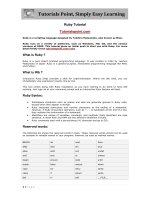pascal tutorial english ebook
Bạn đang xem bản rút gọn của tài liệu. Xem và tải ngay bản đầy đủ của tài liệu tại đây (2.1 MB, 169 trang )
Pascal Tutorial
i
PASCAL TUTORIAL
Simply Easy Learning by tutorialspoint.com
tutorialspoint.com
iii
ABOUT THE TUTORIAL
Pascal Tutorial
Pascal is a procedural programming language, designed in 1968 and published in 1970 by Niklaus Wirth and named in
honor of the French mathematician and philosopher Blaise Pascal.
Pascal runs on a variety of platforms, such as Windows, Mac OS, and various versions of UNIX/Linux.
This tutorial will give you great understanding of Pascal to proceed with Delphi and other related frameworks, etc.
Audience
This tutorial is designed for Software Professionals, who are willing to learn Pascal Programming Language in simple and
easy steps. This tutorial will give you great understanding on Pascal Programming concepts, and after completing this
tutorial, you will be at intermediate level of expertise from where you can take yourself to higher level of expertise.
Prerequisites
Before proceeding with this tutorial, you should have a basic understanding of software basic concepts like what is source
code, compiler, text editor and execution of programs, etc. If you already have understanding on any other computer
programming language, then it will be an added advantage to proceed.
Compile/Execute Pascal Programs
If you are willing to learn the Pascal programming on a Linux machine but you do not have a setup for the same, then do
not worry, the compileonline.com is available on a high end dedicated server giving you real programming experience with
a comfort of single click compilation and execution. Yes! it is absolutely free and it's online.
Copyright & Disclaimer Notice
All the content and graphics on this tutorial are the property of tutorialspoint.com. Any content from
tutorialspoint.com or this tutorial may not be redistributed or reproduced in any way, shape, or form without the
written permission of tutorialspoint.com. Failure to do so is a violation of copyright laws.
This tutorial may contain inaccuracies or errors and tutorialspoint provides no guarantee regarding the accuracy of
the site or its contents including this tutorial. If you discover that the tutorialspoint.com site or this tutorial
content contains some errors, please contact us at
iii
Table of Contents
Pascal Tutorial i
Audience i
Prerequisites i
Compile/Execute Pascal Programs i
Copyright & Disclaimer Notice i
Pascal Overview 1
Features of the Pascal Language? 1
Facts about Pascal 1
Why to use Pascal? 2
Environment 3
Installing Free Pascal on Linux 4
Installing Free Pascal on Mac 4
Installing Free Pascal on Windows 4
Text Editor 4
Program Structure 6
Pascal Hello World Example 7
Compile and Execute Pascal Program: 8
Basic Syntax 9
Functions/Procedures 9
Comments 9
Case Sensitivity 10
Pascal Statements 10
Reserved Words in Pascal 10
Character set and Identifiers in Pascal 10
Data Types 12
Pascal Data Types: 12
Type Declarations: 13
Integer Types 13
Constants 14
Enumerated types 14
Subrange Types 15
Variable Types 16
Basic Variables in Pascal 16
Variable Declaration in Pascal 17
Variable Initialization in Pascal 18
Enumerated Variables 19
Subrange Variables 19
Constants 21
iii
Declaring Constants 21
Operators 23
Arithmetic Operators 23
Relational Operators 24
Boolean Operators 26
Bit Operators 27
29
Operators Precedence in Pascal 29
Decision Making 31
Syntax: 34
Flow Diagram: 34
Example: 35
The if-then-else if-then-else Statement 35
Syntax: 35
Syntax: 37
Example: 37
Syntax: 38
Flow Diagram: 39
Example: 40
Syntax: 40
Flow Diagram: 41
Example: 41
Syntax: 42
Example: 42
Loops 43
while-do loop 44
Syntax: 44
Flow Diagram: 45
Example: 45
For-do LOOP 46
Syntax: 46
Example: 47
47
Repeat-Until Loop 48
Syntax: 48
For example, 48
48
Flow Diagram: 48
Example: 49
iii
Example: 50
Loop Control Statements: 52
Syntax: 52
Flow Diagram: 52
Example: 53
Syntax: 54
Flow Diagram: 54
Example: 55
Syntax: 56
Flow Diagram: 56
Example: 57
Functions 58
Subprograms 58
Functions 58
Defining a Function: 59
Function Declarations: 60
Procedure 62
Defining a Procedure: 62
Procedure Declarations: 63
Calling a Procedure: 63
Recursive Subprograms 64
Arguments of a Subprogram: 66
Variable Scope 70
Local Variables 70
Global Variables 71
Strings 74
Examples 74
Pascal String Functions and Procedures 76
Boolean 79
Declaration of Boolean Data Types 79
Example: 80
Arrays 81
Declaring Arrays 81
Types of Array Subscript 82
Initializing Arrays 83
Accessing Array Elements 83
Pascal Arrays in Detail 84
Two-Dimensional Arrays: 85
Initializing Two-Dimensional Arrays: 85
iii
Accessing Two-Dimensional Array Elements: 85
Declaring Dynamic Arrays 86
Declaring Packed Arrays 88
Pointers 90
What Are Pointers? 90
Printing a Memory Address in Pascal 91
NILL Pointers 92
Pascal Pointers in Detail: 93
Incrementing a Pointer 94
Decrementing a Pointer 94
Pointer Comparisons 95
Records 101
Defining a Record 101
Accessing Fields of a Record 102
Records as Subprogram Arguments 103
Pointers to Records 104
The With Statement 106
Variants 108
Declaring a Variant 108
Example: 109
Sets 110
Defining Set Types and Variables 110
Set Operators 111
Example: 112
File Handling 114
Creating and Writing to a File 115
Reading from a File 115
Files as Subprogram Parameter 116
Text Files 117
Appending to a File 118
File Handling Functions 118
Memory Management 124
Allocating Memory Dynamically 124
Resizing and Releasing Memory 126
Memory Management Functions 127
Units 131
Using Built-in Units 131
Creating and Using a Pascal Unit 132
Date Time 135
iii
Getting the Current Date & Time: 135
Various Date & Time Functions: 136
Objects 142
Object Oriented Concepts: 142
Defining Pascal Objects 143
Visibility of the Object Members 146
Constructors and Destructors for Pascal Objects: 146
Inheritance for Pascal Objects: 148
Classes 152
Defining Pascal Classes: 152
Visibility of the Class Members 155
Constructors and Destructors for Pascal Classes: 156
Inheritance: 157
Interfaces: 160
Abstract Classes: 160
Static Keyword: 161
TUTORIALSPOINT
Simply Easy Learning Page 1
Pascal Overview
This chapter describes the basic definition and concepts of Pascal.
P
ascal is a general-purpose, high-level language that was originally developed by
Niklaus Wirth in the early 1970s. It was developed for teaching programming as a
systematic discipline and to develop reliable and efficient programs.
Pascal is Algol-based language and includes many constructs of Algol. Algol-60 is a subset
of Pascal. Pascal offers several data types and programming structures. It is easy to
understand and maintain the Pascal programs.
Pascal has grown in popularity in the teaching and academics arena for various reasons:
Easy to learn.
Structured language.
It produces transparent, efficient and reliable programs.
It can be compiled on a variety of computer platforms.
Features of the Pascal Language?
Pascal has the following features:
Pascal is a strongly typed language.
It offers extensive error checking.
It offers several data types like arrays, records, files and sets.
It offers a variety of programming structures.
It supports structured programming through functions and procedures.
It supports object oriented programming.
Facts about Pascal
The Pascal language was named for Blaise Pascal, French mathematician and
pioneer in computer development.
Niklaus Wirth completed development of the original Pascal programming
language in 1970.
CHAPTER
1
TUTORIALS POINT
Simply Easy Learning Page 2
Pascal is based on the block structured style of the Algol programming language.
Pascal was developed as a language suitable for teaching programming as a
systematic discipline, whose implementations could be both reliable and efficient.
The ISO 7185 Pascal Standard was originally published in 1983.
Pascal was the primary high-level language used for development in the Apple
Lisa, and in the early years of the Mac.
In 1986, Apple Computer released the first Object Pascal implementation, and in
1993, the Pascal Standards Committee published an Object-Oriented Extension to
Pascal.
Why to use Pascal?
Pascal allows the programmers to define complex structured data types and build dynamic
and recursive data structures, such as lists, trees and graphs. Pascal offers features like
records, enumerations, subranges, dynamically allocated variables with associated
pointers and sets.
Pascal allows nested procedure definitions to any level of depth. This truly provides a
great programming environment for learning programming as a systematic discipline
based on the fundamental concepts.
Among the most amazing implementations of Pascal are:
Skype
Total Commander
TeX
Macromedia Captivate
Apple Lisa
Various PC Games
Embedded Systems
TUTORIALS POINT
Simply Easy Learning Page 3
Environment
This section describes the environmental setup for running Pascal
T
here are several Pascal compilers and interpreters available for general use.
Among these are:
Turbo Pascal: provides an IDE and compiler for running Pascal programs on
CP/M, CP/M-86, DOS, Windows and Macintosh.
Delphi: provides compilers for running Object Pascal and generates native code
for 32- and 64-bit Windows operating systems, as well as 32-bit Mac OS X and
iOS. Embarcadero is planning to build support for the Linux and Android operating
system.
Free Pascal: it is a free compiler for running Pascal and Object Pascal programs.
Free Pascal compiler is a 32- and 64-bit Turbo Pascal and Delphi compatible
Pascal compiler for Linux, Windows, OS/2, FreeBSD, Mac OS X, DOS and several
other platforms.
Turbo51: it is a free Pascal compiler for the 8051 family of microcontrollers, with
Turbo Pascal 7 syntax.
Oxygene: it is an Object Pascal compiler for the .NET and Mono platforms.
GNU Pascal (GPC): it is a Pascal compiler composed of a front end to GNU
Compiler Collection.
We will be using Free Pascal in these tutorials. You can download Free Pascal for your
operating system from the link: Download Free Pascal
CHAPTER
2
TUTORIALS POINT
Simply Easy Learning Page 4
Installing Free Pascal on Linux
The Linux distribution of Free Pascal comes in three forms:
a tar.gz version, also available as separate files.
a .rpm (Red Hat Package Manager) version.
a .deb (Debian) version.
Installation code for the .rpm version:
Where X.Y.Z is the version number of the .rpm file, and ARCH is one of the supported
architectures (i386, x86_64, etc.).
Installation code for the Debian version (like Ubuntu):
Where XXX is the version number of the .deb file.
For details read: Free Pascal Installation Guide
Installing Free Pascal on Mac
If you use Mac OS X, the easiest way to use Free Pascal is to download the Xcode
development environment from Apple's web site and follow the simple installation
instructions. Once you have Xcode setup, you will be able to use the Free Pascal compiler.
Installing Free Pascal on Windows
For Windows, you will download the Windows installer, setup.exe. This is a usual
installation program. You need to take the following steps for installation:
Select a directory.
Select parts of the package you want to install.
Optionally choose to associate the .pp or .pas extensions with the Free Pascal
IDE.
For details read: Free Pascal Installation Guide
Text Editor
This will be used to type your program. Examples of few editors include Windows Notepad,
OS Edit command, Brief, Epsilon, EMACS, and vim or vi.
rpm -i fpc-X.Y.Z-N.ARCH.rpm
dpkg -i fpc-XXX.deb
TUTORIALS POINT
Simply Easy Learning Page 5
Name and version of text editor can vary on different operating systems. For example,
Notepad will be used on Windows and vim or vi can be used on Windows as well as Linux
or UNIX.
The files you create with your editor are called source files and contain program source
code. The source files for Pascal programs are typically named with the extension .pas.
Before starting your programming, make sure you have one text editor in place and you
have enough experience to write a computer program, save it in a file, compile it and
finally execute it.
TUTORIALS POINT
Simply Easy Learning Page 6
Program Structure
This section describes basic Pascal program structure so that we can take it as a reference
in upcoming chapters.
A
Pascal program basically consists of the following parts:
Program name
Uses command
Type declarations
Constant declarations
Variables declarations
Functions declarations
Procedures declarations
Main program block
Statements and Expressions within each block
Comments
Every Pascal program generally have a heading statement, a declaration and an execution
part strictly in that order. Following format shows the basic syntax for a Pascal program:
CHAPTER
3
program {name of the program}
uses {comma delimited names of libraries you use}
const {global constant declaration block}
var {global variable declaration block}
function {function declarations, if any}
{ local variables }
begin
end;
procedure { procedure declarations, if any}
{ local variables }
begin
end;
begin { main program block starts}
end. { the end of main program block }
TUTORIALS POINT
Simply Easy Learning Page 7
Pascal Hello World Example
Following is a simple Pascal code that would print the words "Hello, World!":
Let us look various parts of the above program:
The first line of the program program HelloWorld; indicates the name of the
program.
The second line of the program uses crt; is a preprocessor command, which tells the
compiler to include the crt unit before going to actual compilation.
The next lines enclosed within begin and end statements are the main program block.
Every block in Pascal is enclosed within a begin statement and an end statement.
However, the end statement indicating the end of the main program is followed by a
full stop (.) instead of semicolon (;).
The begin statement of the main program block is where the program execution
begins.
The lines within (* *) will be ignored by the compiler and it has been put to add a
comment in the program.
The statement writeln('Hello, World!'); uses the writeln function available in Pascal
which causes the message "Hello, World!" to be displayed on the screen.
The statement readkey; allows the display to pause until the user presses a key. It is
part of the crt unit. A unit is like a library in Pascal.
The last statement end. ends your program.
program HelloWorld;
uses crt;
(* Here the main program block starts *)
begin
writeln('Hello, World!');
readkey;
end.
TUTORIALS POINT
Simply Easy Learning Page 8
Compile and Execute Pascal Program:
Open a text editor and add the above-mentioned code.
Save the file as hello.pas
Open a command prompt and go to the directory, where you saved the file.
Type fpc hello.pas at command prompt and press enter to compile your code.
If there are no errors in your code, the command prompt will take you to the next line
and would generate hello executable file and hello.o object file.
Now, type hello at command prompt to execute your program.
You will be able to see "Hello World" printed on the screen and program waits till you
press any key.
Make sure that free Pascal compiler fpc is in your path and that you are running it in the
directory containing source file hello.pas.
$ fpc hello.pas
Free Pascal Compiler version 2.6.0 [2011/12/23] for x86_64
Copyright (c) 1993-2011 by Florian Klaempfl and others
Target OS: Linux for x86-64
Compiling hello.pas
Linking hello
8 lines compiled, 0.1 sec
$ ./hello
Hello, World!
TUTORIALS POINT
Simply Easy Learning Page 9
Basic Syntax
You have seen a basic structure of Pascal program, so it will be easy to understand other
basic building blocks of the Pascal programming language.
This section shows the basic syntax of Pascal program.
Variables
A
variable definition is put in a block beginning with a var keyword, followed by
definitions of the variables as follows:
Pascal variables are declared outside the code-body of the function which means they are
not declared within the begin and end pairs, but they are declared after the definition of
the procedure/function and before the begin keyword. For global variables, they are
defined after the program header.
Functions/Procedures
In Pascal, a procedure is set of instructions to be executed, with no return value and a
function is a procedure with a return value. The definition of function/procedures will be
as follows:
Comments
CHAPTER
4
var
A_Variable, B_Variable : Variable_Type;
Function Func_Name(params ) : Return_Value;
Procedure Proc_Name(params );
TUTORIALS POINT
Simply Easy Learning Page 10
The multiline comments are enclosed within curly brackets and asterisks as {* *}.
Pascal allows single-line comment enclosed within curly brackets { }.
Case Sensitivity
Pascal is a case non-sensitive language, which means you can write your variables,
functions and procedure in either case. Like variables A_Variable, a_variable and
A_VARIABLE have same meaning in Pascal.
Pascal Statements
Pascal programs are made of statements. Each statement specifies a definite job of the
program. These jobs could be declaration, assignment, reading data, writing data, taking
logical decisions, transferring program flow control, etc.
For example:
Reserved Words in Pascal
The statements in Pascal are designed with some specific Pascal words, which are called
the reserved words. For example, the words, program, input, output, var, real, begin,
readline, writeline and end are all reserved words. Following is a list of reserved words
available in Pascal.
and
array
begin
case
const
div
do
downto
else
end
file
for
function
goto
if
in
label
mod
nil
not
of
or
packed
procedure
program
record
repeat
set
then
to
type
until
Var
while
with
Character set and Identifiers in Pascal
{* This is a multi-line comments
and it will span multiple lines. *}
{ This is a single line comment in pascal }
readln (a, b, c);
s := (a + b + c)/2.0;
area := sqrt(s * (s - a)*(s-b)*(s-c));
writeln(area);
TUTORIALS POINT
Simply Easy Learning Page 11
The Pascal character set consists of:
All upper case letters (A-Z)
All lower case letters (a-z)
All digits (0-9)
Special symbols - + * / := , . ;. () [] = {} ` white space
The entities in a Pascal program like variables and constants, types, functions, procedures
and records, etc., have a name or identifier. An identifier is a sequence of letters and
digits, beginning with a letter. Special symbols and blanks must not be used in an
identifier.
TUTORIALS POINT
Simply Easy Learning Page 12
Data Types
This section shows the data types used in a Pascal program.
D
ata types of an entity indicates the meaning, constraints, possible values,
operations, functions and mode of storage associated with it.
Integer, real, Boolean and character types are referred as standard data types. Data types
can be categorized as scalar, pointer and structured data types. Examples of scalar data
types are integer, real, Boolean, character, subrange and enumerated. Structured data
types are made of the scalar types; for example, arrays, records, files and sets. We will
discuss the pointer data types later.
Pascal Data Types:
Pascal data types can be summarized as below in the following diagram:
CHAPTER
5
TUTORIALS POINT
Simply Easy Learning Page 13
Type Declarations:
The type declaration is used to declare the data type of an identifier. Syntax of type declaration
is:
For example, the following declaration defines the variables days and age as integer type, yes
and true as Boolean type, name and city as string type, fees and expenses as real type.
Integer Types
Following table gives you details about standard integer types with its storage sizes and value
ranges used in Object Pascal:
Type
Minimum
Maximum
Format
Integer
-2147483648
2147483647
signed 32-bit
Cardinal
0
4294967295
unsigned 32-bit
Shortint
-128
127
signed 8-bit
Smallint
-32768
32767
signed 16-bit
Longint
-2147483648
2147483647
signed 32-bit
Int64
-2^63
2^63 - 1
signed 64-bit
Byte
0
255
unsigned 8-bit
Word
0
65535
unsigned 16-bit
Longword
0
4294967295
unsigned 32-bit
type-identifier-1, type-identfier-2 = type-specifier;
type
days, age = integer;
yes, true = boolean;
name, city = string;
fees, expenses = real;
TUTORIALS POINT
Simply Easy Learning Page 14
Constants
Use of constants makes a program more readable and helps to keep special quantities at
one place in the beginning of the program. Pascal allows numerical, logical, string and
character constants. Constants can be declared in the declaration part of the program by
specifying the const declaration.
Syntax of constant type declaration is follows:
Following are some examples of constant declarations:
All constant declarations must be given before the variable declaration.
Enumerated types
Enumerated data types are user-defined data types. They allow values to be specified in a
list. Only assignment operators and relational operators are permitted on enumerated
data type. Enumerated data types can be declared as follows:
Following are some examples of enumerated type declarations:
The order in which the items are listed in the domain of an enumerated type defines the
order of the items. For example, in the enumerated type SUMMER, April comes before
May, May comes before June, and so on. The domain of enumerated type identifiers
cannot consist of numeric or character constants.
const
Identifier = contant_value;
VELOCITY_LIGHT = 3.0E=10;
PIE = 3.141592;
NAME = 'Stuart Little';
CHOICE = yes;
OPERATOR = '+';
type
enum-identifier = (item1, item2, item3, )
type
SUMMER = (April, May, June, July, September);
COLORS = (Red, Green, Blue, Yellow, Magenta, Cyan, Black, White);
TRANSPORT = (Bus, Train, Airplane, Ship);
TUTORIALS POINT
Simply Easy Learning Page 15
Subrange Types
Subrange types allow a variable to assume values that lie within a certain range. For
example, if the age of voters should lie between 18 to 100 years, a variable named age
could be declared as:
We will look at variable declaration in detail in the next section. You can also define a
subrange type using the type declaration. Syntax for declaring a subrange type is as
follows:
Following are some examples of subrange type declarations:
Subrange types can be created from a subset of an already defined enumerated type,
For example:
var
age: 18 100;
type
subrange-identifier = lower-limit upper-limit;
const
P = 18;
Q = 90;
type
Number = 1 100;
Value = P Q;
type
months = (Jan, Feb, Mar, Apr, May, Jun, Jul, Aug, Sep, Oct, Nov, Dec);
Summer = Apr Aug;
Winter = Oct Dec;
TUTORIALS POINT
Simply Easy Learning Page 16
Variable Types
This section shows the variable types used in a Pascal program.
A
variable is nothing but a name given to a storage area that our programs can
manipulate. Each variable in Pascal has a specific type, which determines the size and
layout of the variable's memory; the range of values that can be stored within that
memory; and the set of operations that can be applied to the variable.
The name of a variable can be composed of letters, digits, and the underscore character.
It must begin with either a letter or an underscore. Pascal is not case-sensitive, so
uppercase and lowercase letters mean same here. Based on the basic types explained in
previous chapter, there will be following basic variable types:
Basic Variables in Pascal
Type
Description
Character
Typically a single octet (one byte). This is an
integer type.
Integer
The most natural size of integer for the
machine.
Real
A single-precision floating point value.
Boolean
Specifies true or false logical values. This is
also an integer type.
Enumerated
Specifies a user-defined list.
Subrange
Represents variables, whose values lie
within a range.
String
Stores an array of characters.
CHAPTER
6
TUTORIALS POINT
Simply Easy Learning Page 17
Pascal programming language also allows defining various other types of variables, which
we will cover in subsequent chapters like Pointer, Array, Records, Sets, and Files, etc. For
this chapter, let us study only basic variable types.
Variable Declaration in Pascal
All variables must be declared before we use them in Pascal program. All variable
declarations are followed by the var keyword. A declaration specifies a list of variables,
followed by a colon (:) and the type. Syntax of variable declaration is:
Here, type must be a valid Pascal data type including character, integer, real, boolean, or
any user-defined data type, etc., and variable_list may consist of one or more identifier
names separated by commas. Some valid variable declarations are shown here:
In the previous tutorial, we have discussed that Pascal allows declaring a type. A type can
be identified by a name or identifier. This type can be used to define variables of that
type. For example:
Now, the types so defined can be used in variable declarations:
Please note the difference between type declaration and var declaration. Type declaration
indicates the category or class of the types such as integer, real, etc., whereas the
variable specification indicates the type of values a variable may take. You can compare
type declaration in Pascal with typedef in C. Most importantly, the variable name refers to
the memory location where the value of the variable is going to be stored. This is not so
with the type declaration.
var
variable_list : type;
var
age, weekdays : integer;
taxrate, net_income: real;
choice, isready: boolean;
initials, grade: char;
name, surname : string;
type
days, age = integer;
yes, true = boolean;
fees, expenses = real;
var
weekdays, holidays : days;
choice: yes;
student_name, emp_name : name;
capital: city;
cost: expenses;









